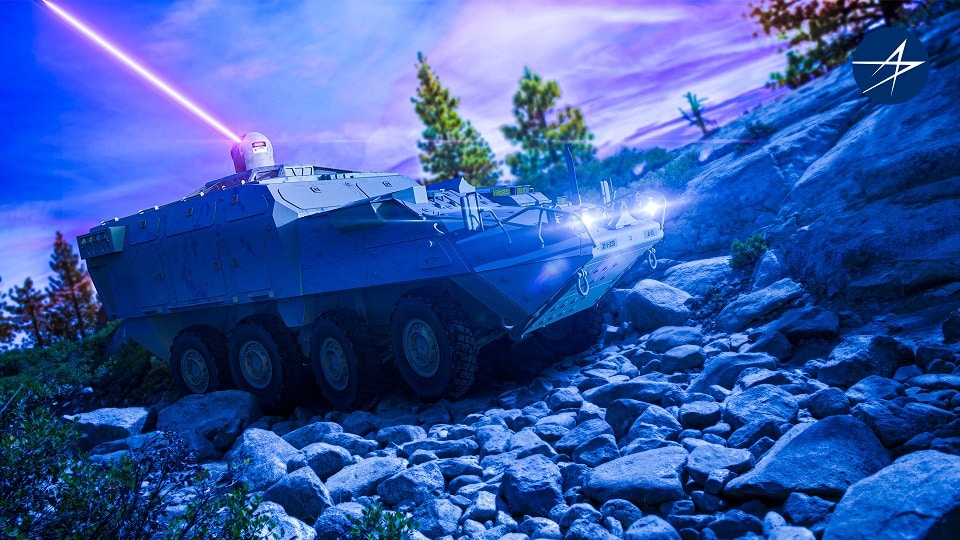Aerospace
Lockheed Martin Achieves First Light In Latest Laser Lab Demonstration

The Directed Energy Interceptor for Maneuver Short-Range Air Defense System (DEIMOS) system by Lockheed Martin has achieved first light, demonstrating that the optical performance parameters of the laser match the system design requirements.
Lockheed Martin’s 50 kW-class DEIMOS system is a ruggedized, tactical laser weapon system that can be integrated into the Stryker combat vehicle to deliver robust directed energy capability to the U.S. Army’s challenging maneuver-short range air defense (M-SHORAD) mission.
Lockheed Martin’s DEIMOS first light demonstration is a crucial milestone along the path to helping the Army perform its DE M-SHORAD mission, which is intended to deliver a maneuverable laser system capable of negating unmanned aerial systems, rotary-wing aircraft and rockets, artillery and mortars.
First light measures the expected beam quality of the system while testing end-to-end performance of our game-changing, low-cost Spectral Beam Combination (SBC) architecture. The key benefit of the company’s SBC is that power can be scaled while retaining the excellent beam quality of the individual fiber lasers.
In 2022, Lockheed Martin demonstrated Layered Laser Defense (LLD) capability by defeating two surrogate cruise missiles at tactically relevant ranges. This LLD capability:
- Shares many common elements with the DEIMOS system architecture, such as allowing for a single operator to engage and destroy SHORAD targets.
- Can be seamlessly integrated into various platforms.
- Can fit on tactical platforms such as a Stryker vehicle because it was designed with constraints in terms of size, weight and power (SWaP).
What’s Next
Utilizing a philosophy of “build a little, test a little, learn a lot,” Lockheed Martin will expand the DEIMOS test program in 2023, culminating with field integration tests in 2024. This thorough approach is designed to reduce risk, to enable soldier touchpoints and to provide proof points of compelling mission capabilities.
The Army’s Rapid Capabilities and Critical Technologies Office (RCCTO) is leading the DE M-SHORAD prototyping effort and is expected to transition the program to the Program Executive Office (PEO) Missiles & Space in 2024.

Aerospace
Boeing Transfers Rocket Stage to NASA, Paving Way for Human Moon Mission

Boeing has achieved a significant milestone by providing NASA with the second core stage of the Space Launch System (SLS) rocket.
This crucial component, crafted at NASA’s Michoud Assembly Facility (MAF), is set to propel the Artemis II crew into lunar orbit, marking humanity’s return to deep space after a 50-year hiatus.
The monumental Boeing-built rocket stage, the largest element of the Artemis II mission, will embark on a journey aboard the Pegasus barge, traveling 900 miles to NASA’s Kennedy Space Center.
Comparison of two legendary aircraft B777x vs B747 aircraft:Click here
Upon arrival, it will be meticulously integrated with other essential Artemis II components, including the upper stage, solid rocket boosters, and NASA’s Orion spacecraft within the iconic Vehicle Assembly Building. This intricate integration process is a vital step toward the eagerly anticipated Artemis II launch, slated for 2025.
“Boeing-built products helped land humankind on the moon in 1969, and we’re proud to continue that legacy through the Artemis generation,” remarked Dave Dutcher, vice president and program manager for Boeing’s SLS program. “Together, with NASA and our industry partners and suppliers, we are building the world’s most capable rocket and paving the way to deep space through America’s rocket factory in New Orleans.”
NASA, Lockheed Martin Reveal X-59 Quiet Supersonic Aircraft:Click here
The delivery of Core Stage 2 marks a significant achievement in the evolution of the SLS rocket. Towering over 200 feet and powered by four RS-25 engines, this core stage, coupled with two solid-fueled booster rockets, will generate a staggering 8.8 million pounds of thrust. This immense power is crucial to launching Artemis II and future missions into the vast expanse of space.
The SLS rocket stands unparalleled in its capability to transport both crew and substantial cargo to the moon and beyond in a single launch. Its extraordinary capacity will facilitate the delivery of human-rated spacecraft, habitats, and scientific missions to destinations including the moon and Mars, ushering in a new era of space exploration.
-

 Travel1 week ago
Travel1 week agoAir India to Expand US Operations with Three New Routes After a Decade
-

 Travel2 weeks ago
Travel2 weeks agoWhy We Should Avoid These Stamps in a Passport
-

 Airlines1 month ago
Airlines1 month agoInvestigations Reveal Fake Chinese Titanium in Boeing and Airbus Jets
-

 Tech4 weeks ago
Tech4 weeks agoChina’s CATL Plans 1,800-Mile Electric Plane Launch by 2027
-

 Airport3 days ago
Airport3 days agoTop 10 Largest Airports in the World by Size
-

 Aerospace4 weeks ago
Aerospace4 weeks agoChina’s Fighter Jets Turn Wings into Autonomous Drones
-

 Airlines4 days ago
Airlines4 days agoAir India Rolls Out A350s for Delhi-New York JFK and Newark Routes
-

 Defence3 weeks ago
Defence3 weeks agoBoeing Enhances Chinook with New Engines and Block II Upgrades at $96 Million







